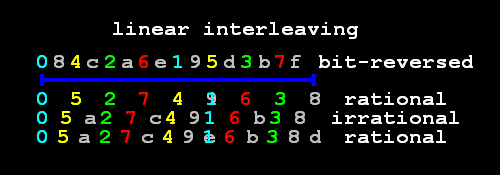
| fully interleaved digital video more nearly represents real, tending infinite, resolution of near-binary (1-bit) photons |
[Topically related to Progressive Image Resolution for bandwidth-defined image-cruising; and Television's Original NTSC Concept]
* (x,y:x 'exor'ed is more-often centrally intersticed: 0,0 → 1,1 ; 0,1 → 1,0 ; NB. Aspecting it √2:1 also equalizes it slightly further.)
In ordinary raster scan line-upon-line down the screen, left-right adjacent pixels are displayed consecutively and frame-repetitiously: precise only to the available resolution of the viewing screen, and up-close appearing coarsely quantized jagged-edged 'digitized'; and as with NTSC resolution, yielding rather crude definition, albeit easy to implement and compress if the original camera has twice the "Nyquist" resolution to detect straddled edges (See also semipixeling). Standard interleaved raster scan was but a first-step toward fully-interleaved,- suffering severe artifacting in field-alternated combing of the image strobing at the edges with visible flickering and vertical motion of diagonals developing serrated edges, -which catch the visual attention and pull side-ways rather than vertically-... Even progressive-raster scan (the newer DV/HDDV standard) -still- has some of that artifacting, as when downward-moving objects appear larger by strobe-affection than when upward-moving; --if it has a sliding shutter as is ordinary for full-light capture.
(Interleaving as-was could have been improved,- for example, by choosing 3x5 subpixeling.)
In fully interleaved scanning, consecutively displayed pixels correspond to -nonadjacent- placements about half the width, vertical, horizontal, of the viewing screen, apart,- and are theoretically never the same placement (* as precisely as the x,y-coordinates are maintained, but truncating the x,y indices at the receiver results in minutely invisible image jitter, shifting of less than the width of the minimum design pixel). Cf ordinary spontaneous photon production by illumined objects, consecutive photons (pixels) are seeming random, and average similarly apart about half the width of the viewing screen: being uniformly distributed, and finely resolved to inter-atomic distances.
* (High definition raster-scan cameras can approximate this never-strike-the-same-place photon, and its higher resolution, by using a smaller pixel active-area, -by not-using a micro-lens over the pixel to gather more light,- and by keeping the camera always in motion, about half a pixel per frame vertical or horizontal or combined thereof, which amounts to about a minute per screen-height-or-width, or circularity. A factor of four reduces amplitude resolution by 2 bits, of typically 12 today. The receiver-set display would likewise also benefit by using narrower pixels. But, note also, alternatively, rather than reducing the pixel to minuscule, it can be segmented to subpixels, each sub-addressed within the pixel: interleaving at the light-receptor: a simpler, near-compatible, local randomization.)
It is well-known that high resolution requires less temporal resolution, the total resolution being deemed bandwidth limited,- and this fully interleaved x,y-indexing achieves this bandwidth more usefully, its intermediate placements being less frequently addressed; and moving objects do not pattern on fully interleaved pixel-sampling,- and therefore have no motion artifacts ... (However, note then that compression algorithms based on pixel adjacency would need calculate each temporal and spatial distance, which are not fixed-width).
Additionally, It is also known that high resolution requires less amplitude resolution,
even one-bit per pixel (photon): cf the ordinary photon is single-valued from any atom.
(This makes compression algorithms altogether more statistically-oriented.)

But, radix-reversed binary jumping is inconstant: working evenly only at whole levels, and each double the prior-level resolution ... Evenness can be achieved faster by constant step interleaving at high-relative-prime rational approximating irrational step fill ... (eg. compare bit-reversed to steps of 0.6250, 0.6180, 0.6154.)
The direct first estimate is the small golden ratio, √5-1/2 ~ 0.618 , where each jump subdivides the larger remaining interval by that same ratio, and nearer the older; Second jumps, 1.236 , are like the binary second jumps at 1.25 . And, though luminance decay is not a concern on a few pixel-times, nevertheless the next jump subdivides the previously remaining smaller interval by that ratio and nearer the oldest, on its other side;-- and the jump thereafter gets the other equal interval ... thus tending to filling with randomlike spread.
(Est. 2 c - 1 = c(1-c) → c² + c - 1 = 0 → c = g.r. ; not unlike the natural spindle-winding sprouting-angle in many vegetations. QEI)
[under construction] On a flat screen, the x,y-jump coefficients and the screen size must all be relatively irrational ... for example if we take y-slope = ... keeping the cumulated units of x with x-jump = g.r., then the y-jump = ...Σ x is relatively irrational,. ... Assuming each pixel down represents its neighborhood, ... On a spherical screen ... the two previous jumps ...